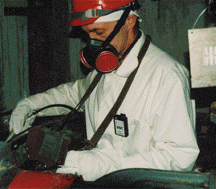Safety Improvements at the Chornobyl Shelter
Worker Protection - Radiation Dose Reduction |
Shelter workers are exposed to significant levels of radiation. They need dosimetry equipment to track the exposure of each individual and protective equipment to reduce their exposure.
 Fig. 3 - This worker takes a radiation survey in the shelter of Chornobyl Unit 4. He is using a U.S. hand-held radiologic survey instrument and wearing a U.S.-type respirator and U.S. electronic dosimeter. |
The United States is supplying air-monitoring equipment, radiation protection clothing, and dosimeters. The United States also is supplying software to track worker exposure and to plan work for managing the level of exposure to each worker over time.
The United States has delivered the following dosimetry equipment to record each worker's exposure:
- 500 electronic dosimeters
- 5 dosimeter readers
- a full complement of dosimeter spare parts
- 28 portable radiation survey instruments (of five types).
Science Applications International Corporation, a U.S. contractor, is providing on-site training in the use of dose-reduction equipment and methods.
The United States is purchasing the following dosimetry equipment, to be delivered early in 1998:
- 6,000 thermoluminescent dosimeters, with readout equipment
- 45 telemetered electronic dosimeters
- 2 continuous air monitors for evaluation (20 will be provided)
- radiation access control software
- excess FEMA radiation calibration sources
- 2 air samplers for evaluation (5 will be provided).
The United States has delivered the following equipment for worker radiological protection:
- 4 SeaLand containers of U.S. Department of Energy radiation work area clothing and respirators
- 4 portable work enclosures.
The United States is delivering 500 lead blankets for temporary shielding. These will be used initially to protect workers repairing the ventilation stack shared by reactor Units 3 and 4.
The United States has provided computer software for database and project management. Shelter personnel will use the STREAM software to organize, archive, and use their vast store of information and data. They also will use it to plan work and to log work progress and completion. Developed by the U.S. Department of Energy, STREAM currently is used at the Hanford nuclear site in Washington state to support decontamination and decommissioning. U.S. experts are modifying STREAM to make it specific for use at the shelter. The team has traveled to Ukraine to introduce the code, provide initial training, initiate data digitizing, and begin the input of floor plans, photographs, videotapes, and radiological data.
| The 1986 Disaster/The Unstable Shelter | Closure of the Chornobyl Plant | Preventing Collapse of the Shelter | Worker Protection | Additional Safety Projects | |